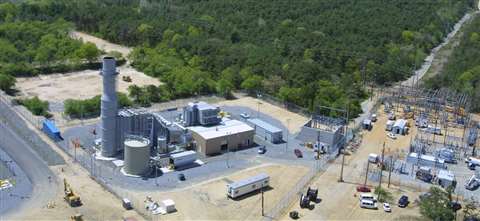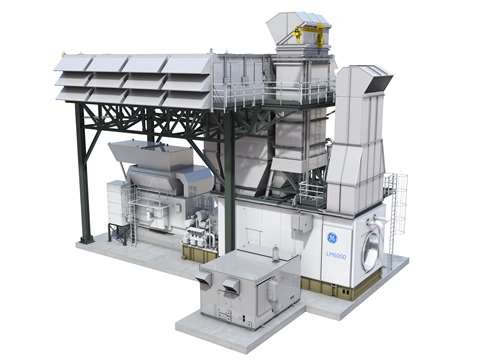Power Plants of the World: A hydrogen pilot by GE
Special Features Series Sponsored By INNIO08 March 2023
08 March 2023
Project showed substantial reductions in CO2 emissions, GE says

GE’s LM6000 aeroderivative gas turbine successfully operated on blends of up to 44% (by volume) green hydrogen in a pilot project at the New York Power Authority’s Brentwood Power Station on Long Island. Tests revealed a clear reduction in CO2 emissions with higher blends of hydrogen paving the way for a net zero carbon future and further development of green hydrogen at other sites, according to GE. The project also revealed substantial reductions in CO emissions, which could lead to additional benefits when operating on hydrogen blends, the company said.
New York has mandated, through its Climate Leadership and Community Protection Act (CLCPA), to generate 70% of the state’s electricity from renewable sources by 2030 and 100% zero-emission electricity by 2040. This is expected to provide a strong incentive to explore alternatives to natural gas. While renewables, such as wind and solar, are likely to provide most of the electricity to the region, low-carbon fuels can play a significant role and be part of the solution, GE said.
The ability to retrofit GE turbines that power one-third of the world’s electricity generation potentially paves the way to a decarbonization journey for the power generation industry. GE has more than 100 gas turbines globally that have or are running on between 5% and 100% hydrogen in 20 countries and one of these is installed at the New York Power Authority (NYPA)’s Brentwood Power Station. The plant, powered by a GE LM6000 aero-derivative gas turbine, was commissioned in 2001 to increase power generation capacity for Long Island and New York City in anticipation of shortages.
GE said that NYPA, the biggest public power utility in the US, has signaled the energy transition is underway in the state with its Brentwood Power Station on Long Island representing the vanguard of a green hydrogen future. In 2022, NYPA became one of the first utilities to burn green hydrogen in a retrofitted natural gas power plant in commercial operation. This required coordination between all parties involved in the project, the local grid authority, and other state agencies.
While most hydrogen is made via steam methane reforming — in which natural gas (CH4) reacts with steam under pressure and heat to produce hydrogen (H2), carbon monoxide (CO), and carbon monoxide (CO2) — green hydrogen is made through electrolysis. In this process, an electric current splits water (H2O) into its constituent elements to produce oxygen (O2) and hydrogen (H2). If the process uses renewable power, which by definition does not generate CO2 emissions, this is known as green hydrogen.
In the spring of 2022, NYPA conducted a green hydrogen fuel demonstration, investigating the potential of substituting hydrogen—produced using hydroelectric power—for a portion of the natural gas used to fuel NYPA’s Brentwood Power Station.

GE’s aeroderivative gas turbine portfolio currently has the capability to burn blends of hydrogen and natural gas; the specific limit depends on the combustion system configuration. For example, GE’s LM2500 GE’s aeroderivative gas turbines can run on blends of up to 85% hydrogen (by vol.) using a single annular combustor (SAC) configuration with water injection to control emissions, with a path towards a 100% hydrogen combustion in the future.
The demonstration project was part of a collaboration between NYPA, GE, the Electric Power Research Institute (EPRI), engineers Sargent and Lundy, Fresh Meadow Power and Airgas, a subsidiary of French-based Air Liquide. The team examined the impact of fuel blends from 5% to 44% (by volume) hydrogen, which represents some of the highest volumes of hydrogen blended into a commercially operating gas turbine. As the gas turbine original equipment manufacturer, GE supplied a hydrogen/natural gas blending system and supported the project’s planning and execution.
During the project, the team examined the impact of water injection rates while operating on the hydrogen fuel blend and demonstrated that NOx emissions could be kept the same or even slightly reduced, but this required an increase in the water injection rate. With the Brentwood Power Station generating 47 MW, according to the Electric Power Research Institute’s report carbon dioxide emission rates were reduced by about 14% with a fuel blend containing 35% hydrogen, which matched pre-test predictions. Engine control was stable throughout the duration of the test; combustion dynamic pressure (i.e., amplitudes) measured during the test indicated no change during operation on the blend. Combustion equipment was in good condition before, during and after the test; periodic borescope inspections showed no apparent damage to combustion hardware due to operation on hydrogen blends.
In addition to demonstrating that the fuel blend could generate electricity with lower carbon emissions, the demonstration highlighted that under certain conditions, other emissions, including nitrogen oxides (NOx), carbon monoxide (CO) and ammonia (NH3), were maintained below regulatory operating permit limits using the existing selective catalytic reduction and CO catalyst post-combustion control systems. In fact, CO levels decreased as much as 88% as the hydrogen fuel fraction increased. This finding could help allow gas turbines that run on hydrogen/natural gas blends operate across a wider load range with reduce or without CO oxidation catalysts, potentially reducing operating costs. These are critical findings, as they demonstrate the ability to reduce carbon emissions without increasing plant emissions of other pollutants, GE said.
GE said the NYPA project also highlights that gas turbines like the Brentwood LM6000 that operate as ‘peakers’ can simultaneously help to maintain a reliable electrical grid and provide electricity with lower carbon emissions. The lower CO emissions while operating on a blend of hydrogen and natural gas might have longer-term benefits by improving gas turbine operational flexibility, which may become more important when supporting a grid with an increasing percentage of variable renewable power.
Efforts like the Green Hydrogen Demonstration Project are vital to validate the important role that hydrogen can play in lowering carbon emissions from power generation while also providing reliable and affordable power, according to GE.
NYPA’s project is revealing new understandings impacting well beyond New York. According to GE, there were approximately 1.6 terawatts (billion MWs) of gas turbines installed globally as of YE 2020 accounting for around 21% percent of global power generation. The imperative is to systematically approach turning existing and future high-efficiency gas generation assets into a zero- or near-zero-carbon energy resource and sharing the results of this study with the industry and the public can help pave the way to future decarbonization efforts.
STAY CONNECTED




Receive the information you need when you need it through our world-leading magazines, newsletters and daily briefings.
POWER SOURCING GUIDE
The trusted reference and buyer’s guide for 83 years
The original “desktop search engine,” guiding nearly 10,000 users in more than 90 countries it is the primary reference for specifications and details on all the components that go into engine systems.
Visit Now
CONNECT WITH THE TEAM











